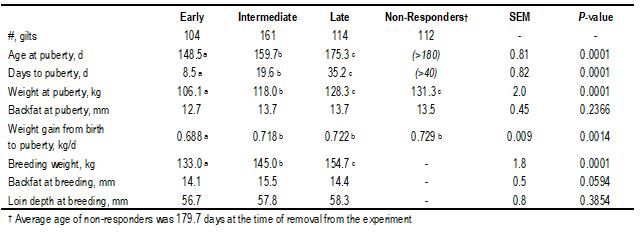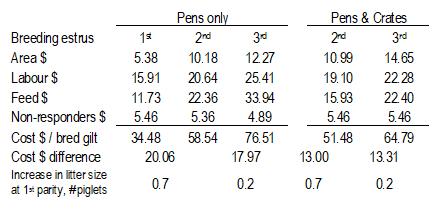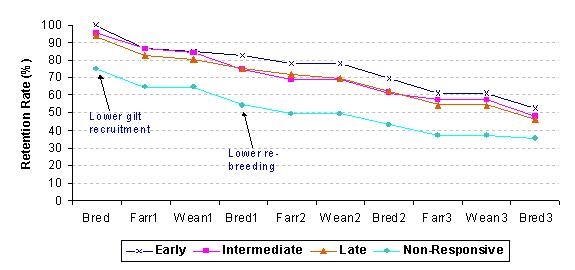| | Conclusions | Funding
In this short review, we have selected and prioritized the most important, non-negotiable aspects of gilt development. We feel strongly that emphasis on these aspects will ensure a steady supply of replacement gilts and contribute to enhanced sow retention in the herd. Analysis of these aspects will also focus your attention on the Gilt Development Unit (GDU), currently the most underestimated cost centre in modern swine operations.
1. Recognize the Gilt Development Unit
Unless production systems are large enough to justify separate replacement gilt/first-parity sow farms (i.e., segregated parity management), little is done in traditional herds to recognize the critical role of the GDU. That is, to consistently meet targets for the supply of high quality bred or ready-to-breed gilts.
Often, several issues in the GDU are overlooked: 1) there is no physical separation by design of the GDU from the rest of the breeding herd; 2) replacement gilts are housed among older multiparous sows; 3) replacement gilts are housed with or near culled sows and sick animals; 4) replacement gilts are only permitted fenceline contact to intact boars. To address these common concerns, a separate barn area for the GDU is considered essential.
Many producers overlook effects on both overall production efficiency and costs aspects of replacement gilt management. Improvements in production efficiency have mainly focused on piglet survival, nursery and growout performance, appropriate shipping weights, and management of the lactating and weaned sow. In contrast, replacement gilts are often bred at poorly defined targets for body weight, condition and age, with the intention of ensuring sow longevity. Thus, gilts frequently accumulate unnecessary non-productive days (NPDs) and are bred at excessive body weights and condition, indicating a lack of realization that the GDU is a very significant cost centre.
2. Set Goals, Clarify Roles & Provide Training
Recognizing why breeding targets are important is more relevant than achieving breeding targets. If employees are hired or moved from other production areas, it is often assumed that they know what is expected. We are perhaps too busy to explain to employees the "whys". Take time to emphasize to GDU personnel what's important and how their responsibilities affect the whole production system. Stating clear goals, describing roles and providing recurring personnel training, in our opinion, are also important non-negotiable aspects of gilt development.
3. Meet Gilt Breeding Targets
Consistently meeting targets for the supply of bred or ready-to-breed gilts is the next non-negotiable aspect of gilt development. This underlies the importance of the "push" concept of gilt management. A regular supply of bred gilts entering the herd 1) allows a consistent weaning age and flow of weaned pigs, 2) drives optimal farrowing, nursery and growout space utilization, and 3) drives a consistent policy of sows culls, which results in a stable herd parity structure. Therefore, failing to achieve set gilt breeding targets has detrimental consequences on herd productivity and profitability.
4. Provide a Steady Boar Supply
Too often, personnel or their direct supervisors fail to budget, schedule and allocate a steady supply of boars to the GDU. It takes two to tango, and the role of the boar is pivotal in this dance! A constant and adequate supply of mature (older than 10 months), high libido (sexually motivated), epididimectomized or vasectomized boars (teaser boars) is essential to achieve the targeted number of breeding-eligible gilts (recorded heat-no-serve) within the required time and with less personnel frustration and time-wasting. Ideally, puberty stimulation should consist of at least 15 minutes of daily direct physical boar exposure (not just fenceline) with a gilt:boar ratio of no greater than 15:1. Teaser boars should not be used to check gilts for more than one hour per day. Thus, ensure that there are sufficient boars in the GDU at all times. A system that supplies and makes efficient use of good boar stimulation is another non-negotiable aspect of gilt development.
5. Make Swift Changes to Improved Lines
Due to health concerns, many producers have reverted to closing their herds. However, in-herd selection of replacement gilts must be linked to a rigorous program of ongoing genetic improvement within these closed herds. More frequent changes to improved genetic lines may be essential in the future due to packer demands for different carcass traits. Dragging these changes in genetic lines over many months destabilizes herd health status, creates fluctuation in the number of pigs born and marketed, increases variation in growth performance within closeout groups and reduces the consistency and uniformity of carcasses that packers seek. Non-negotiable aspects of gilt development should therefore include not initiating changes to improved genetic lines until they are properly planned and executable within a reasonable timeframe.
6. Evaluate Puberty Stimulation in Isolation/Acclimation Barns
A major inefficiency in many large production systems is that puberty stimulation is not started until incoming replacement gilts reach the destination herd. The use of teaser boars in isolation/acclimation barns could 1) serve as sentinel animals, 2) be a source of pathogens from the destination herd, and 3) provide the stimulus needed for induction of an earlier pubertal heat in gilts. What is precluding large systems from realizing the considerable savings in reduced non-productive days by adopting this practice? Alternatively, moving gilts to isolation/acclimation barns at a younger age and thus providing younger gilts to the destination breeding farms for stimulation will also reduce gilt NPDs.
7. Start Puberty Stimulation 30 Days Prior to Maximum Allowable Market Weight
Puberty stimulation should start about 30 days prior to gilts reaching the maximum allowable live market weight. This live weight corresponds to the carcass weight at which carcass index drops swiftly. If puberty stimulation is delayed, often gilts that do not exhibit first estrus within the specified time become too heavy to ship according to the local market scheme. This results in significant economic penalties for producers. In Alberta, this maximum allowable live weight is 125kg (275lb). Thus, we initiate puberty stimulation with the boars at 150-160 days of age to ensure that non-responders have been identified by 180-190 days when they would normally reach 125kg (265lb). Timely puberty stimulation to prevent the loss in carcass value of culled, non-responder gilts, is another non-negotiable aspect of gilt development.
8. Identify the Most Fertile Females
The importance of selecting only gilts that quickly respond to boar stimulation is evident from a study we conducted at Prairie Swine Centre Inc. (PSCI). Gilts were exposed to boars starting at 140d of age and categorized by their response to boar stimulation and age at puberty. Gilts that exhibited estrus within 40 days of stimulation were classified as "Select" ("Early", "Intermediate" and "Late") (Table 1) and any gilt that did not exhibit estrus was considered as "Non-select". All Select gilts were bred at their third estrus (Table 1). Non-select gilts were added to the herd as "Opportunity" gilts by the production staff using available techniques (i.e., PG600™). Of these Opportunity gilts, only two thirds were ever bred, and retention after weaning the first litter was also significantly lower (Figure 1).
We recommend a non-negotiable, selectable gilt pool of 125% of target needs. Expect 22% of gilts not to cycle during the 30-day boar stimulation period and 3% to be culled. The 25% of non-responding gilts should ideally be sent to slaughter. However, if there is a shortfall of known cyclic gilts to meet breeding targets, non-responding gilts could enter the herd as "Opportunity" gilts.
9. Breed on the Basis of Weight and Not Age
Experimental data and cost/benefit analysis have led us to conclude that breeding on the basis of weight and recorded heat-no-serve is the most cost-effective strategy. Breeding on the basis of age is inappropriate and an inadequate benchmark to use.
Breeding at a fixed estrus does not account for the large variation in both age (132 - 190d) and weight (75.8-151.4kg) at puberty observed in the PSCI study (Table 1). Breeding gilts at second estrus if possible and within a narrow weight range is a far more effective strategy.
Generally, delaying breeding from first to second estrus gives a 0.7 pig increase in first litter size. In contrast, delaying breeding from second to third estrus only increases litter size by 0.2 pigs for the same extra cost (Table 2). Thus, breeding should only be delayed to third estrus to achieve an acceptable breeding weight.
Recent data from our own (Emma Clowes) and other groups indicate that a greater body mass after farrowing (>180kg or 400lb) protects against excessive loss of lean mass during the first lactation. Therefore, our current recommendation is to breed gilts between 135 and 150kg (300-330lb), at second or third estrus. Assuming a 35 to 40kg (80-90lb) weight gain during gestation, this results in a weight of >180kg (~400lb) after farrowing.
To meet these critical targets for breeding weight, information on gilt weight and growth rate, either at the onset of boar stimulation, or at around the time of pubertal estrus, is becoming a non-negotiable aspect of effective GDU management.
10. Avoid Slow Growing Gilt
Slow growth rates during rearing (<0.6kg/d) delay the onset of puberty. Even in early responding gilts, lower growth rates (<0.65kg/d) also increase the number of days from entry to service if target breeding weight (135 - 150kg) is to be met. In many systems, cyclic gilts bred at lighter weights and not rebred after weaning their first litters are a major contributor to high annual replacement rates. To avoid this risk and to reduce gilt NPDs, we require a minimal grow target to be met (90kg at 140d) by gilts entering the boar stimulation phase of the GDU program.
11. Use Pharmacological Aids Wisely
PG600TM was designed as a substitute method to boars for inducing puberty. However, the effectiveness of PG600TM treatment in identifying the most fertile gilts vs. boar-induced early pubertal heat is still uncertain. There is clearly no need to use such a product in gilts that respond to boar stimulation. PG600™ has been traditionally used in gilts that have not shown pubertal estrus in the presence of boars after say 21 or 28 days. However, gilts not responding to either boar stimulation or PG600™ by a defined target time (day 30 in our system) must be culled and will hopefully be below the maximum allowable live market weight.
The US Food and Drug Administration has recently approved the use of altrenogest (Matrix™) to synchronize estrus in groups of gilts. Even when this product becomes registered in Canada, the expected high cost (CDN$35/gilt treated) demands efficient use of the product. However, if used only in recorded heat-no-serve gilts, altrenogest treatment allows gilt breeding targets to be met with even greater precision, over a shorter breeding week and from a smaller pool of replacement gilts.
12. Emphasize Data Recording
Collecting and analyzing data takes time and effort. So what is the minimum amount of information required to run the GDU?
Don't collect data on gilts prior to the 30-day boar stimulation period even if you notice them in heat. Knowing the age and weight of groups or pen of gilts to be stimulated is important but not crucial. However, having reliable records of observed standing heats is non-negotiable.
List individual gilt IDs in a pen to be stimulated on charts (rows) and record their progressive standing heat score (Table 3) on a daily basis (columns) from the start of boar stimulation. Gilts not standing by a preset day (day 23 in our 30-day boar stimulation period) may be candidates to receive PG600™ if projected breeding targets will not be met from known cyclic gilts. Any gilt not responding within 30d to boar stimulation should be considered a non-responder and be shipped to slaughter promptly. All this information should be clearly recorded on the data sheets and entered into record keeping systems on a regular basis. Until gilts are bred, dates of subsequent standing heats during good fence-line contact with good libido boars must be recorded.
We have recently become more emphatic about the need to weigh gilts at the heat-no-serve estrus and then to designate breeding at second or third estrus. This strategy ensures that they are within the 135 - 150kg recommended breeding weight range. Knowing breeding weight and backfat depth also allows us to calculate the desired weight gain during gestation and to feed gilts to reach adequate protein mass at farrowing y adjusting dietary lysine content and feeding level during gestation.
Table 1. Characteristics measured at the onset of puberty (1st estrus) and at breeding (3rd estrus)

Table 2. Cost vs. benefit of delaying estrus for gilts housed in pens only until breeding or in pens until after the onset of puberty and subsequently in crates until breeding at either second or thrid estrus.

Table 3. Heat progression scores including vulva and behavioural changes

Figure 1. Retention Rate for Early, Intermediate, Late and Non-Responsive Gilts

Conclusions
Our research has identified important differences in production efficiency related to gilt selection based on a recorded first estrus in response to boar stimulation. Considered together with increased costs of higher replacement rates, costs of time spent on unproductive heat checks and increased breeding costs per pig born, our data suggest substantial savings can be realized by identifying late-responding and non-responding gilts at an early age.
Gilt selection based on recorded first heat during periods of good boar contact (heat-no-serve) and management of gilts to achieve more uniform breeding weights will have profound effects on overall breeding herd performance. Therefore, appropriate GDU facilities and effective management protocols should become a non-negotiable part of effective breeding herd management.
For additional information on this topic, visit the SRTC website at http://www.ales2.ualberta.ca/AFNS/SRTC/
Funding
The financial support of SaskPork and the Agricultural Development Fund of Saskatchewan for the PSCI studies is greatly appreciated. The main funding partners supporting the research of the Swine Reproduction-Development Program at the SRTC are Alberta Pork, AARI, NSERC and Hypor Inc. Dr. George Foxcroft presently holds the Canada Research Chair in Swine Reproductive Physiology.
This document is also available in Spanish (169KB PDF) |
|